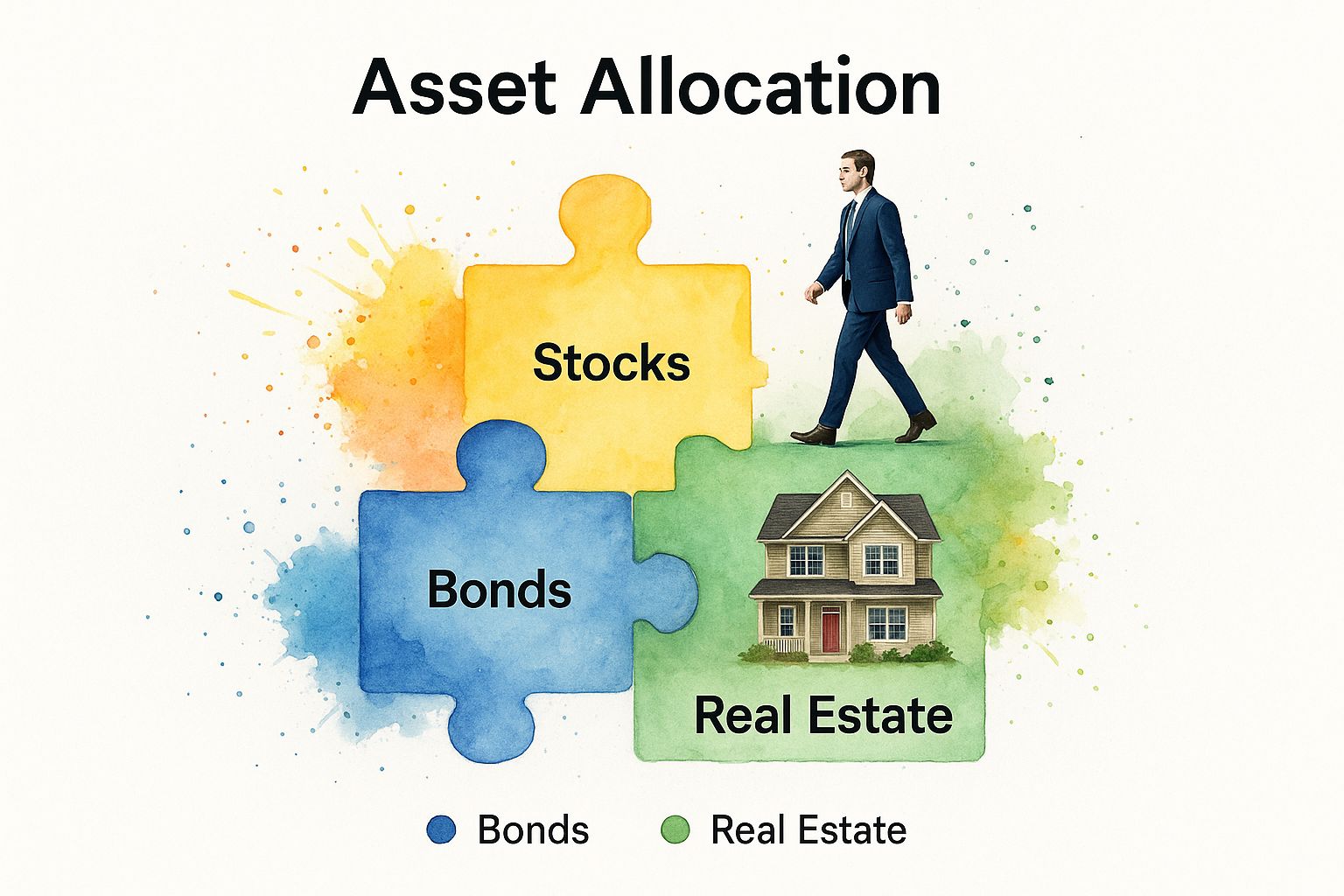Understanding What Modern Portfolio Investment Strategies Really Mean
Let’s clear away the confusion and see what portfolio investment strategies mean for you. Think about building a top-notch sports team. You wouldn’t just pick the world’s best strikers, right? Even though they are great, you need defenders, midfielders, and a goalkeeper too. Each player has a special role, and together they form a stronger team. A smart investment strategy is similar; it’s about creating a balanced mix of assets, not just choosing a few popular stocks.
Wise investors understand this. The old idea of just “buying and holding everything” doesn’t work in today’s markets. We need to think more carefully. This means combining different investments to manage risk while seizing chances. The main idea is to own assets that don’t all move in the same direction. If your stocks drop, maybe your bonds or real estate stay steady or even rise, softening the impact on your portfolio. This is the main point of Modern Portfolio Theory (MPT).
The Basics: Modern Portfolio Theory (MPT)
Modern Portfolio Theory gives us a plan for putting together a portfolio. The goal is to get the most return for a certain amount of risk. It’s not about avoiding risk completely—that’s impossible when investing—but about managing it wisely through diversification. The theory shows that the risk of one asset isn’t as big a deal as how it affects your whole portfolio.
The chart below, from Wikipedia, illustrates a key part of MPT: the efficient frontier.
This graph shows that for any level of risk, there’s a best portfolio that gives the highest expected return. These best portfolios form a curve called the efficient frontier. Any portfolio below this curve is not good enough because you could either get a better return for the same risk or the same return for less risk.
Applying Theory in the Real World
In practice, using this theory goes beyond just stocks and bonds. Today, investors make stronger portfolios by adding more types of assets. Here are some examples:
International Stocks: These let you invest in other countries with different growth patterns.
Real Estate: Owning property or investing in Real Estate Investment Trusts (REITs) can provide income and protect against rising prices.
Commodities: Items like gold or oil are often safe choices when the economy is shaky.
Digital Assets: Though risky, some people are adding a small amount of cryptocurrencies for their growth potential and low link to usual markets.
This isn’t just for big Wall Street players with lots of money. Thanks to platforms with easy-to-use tools and data, everyday investors can now build well-diversified portfolios. The key point is to have a clear plan. By knowing how different assets fit together, you can create a portfolio aimed not only at growth but also at staying strong during market ups and downs, helping you achieve your long-term financial goals.
Asset Allocation Principles That Separate Winners From Losers
Smart investing starts with asset allocation. This means spreading your money across different investments. It’s not about using a random plan from the internet. It’s about matching your choices with your own goals, how much time you have, and how much risk you can handle.
Think of it like building a vehicle. A race car driver and a construction worker need different vehicles. Your portfolio should be just as unique. Successful investors know this well—their choices fit their own goals.
Investing also involves mental strength. Many people hurt their success by making decisions based on emotions. A clear asset plan helps you stay calm. It stops you from selling in a panic when markets fall or buying when trends are high. It guides you to follow “buy low, sell high.” This means selling some assets when they grow too much and buying more of those that are behind during rebalancing.
The infographic shows how main asset types—like stocks, bonds, and real estate—fit together like puzzle pieces to create a full portfolio.

The picture shows that no single asset can stand alone. Their true power is in how they work together. This helps balance growth and risk.
Deciding on Your Plan
To plan your investments, start by thinking about your goals. Are you saving for a house in five years or for retirement in thirty? Your goal changes your plan. If you need money soon, choose safer assets like bonds. If you have more time, you can pick riskier options like stocks.
Your mix of assets protects you from market changes. It also helps you reach your long-term goals. Successful investors aren’t using secrets. They know that spreading out investments wisely matters more than picking specific ones.
Smart Diversification
Real diversification is more than owning many stocks. Some people buy stocks in different companies but are surprised when they all drop in a market crash. This happens because they are still focused on one type of asset—stocks—and one economy. A good strategy is to find assets that act differently from each other.
Think of it like this: owning an umbrella company and a sunglasses brand is better than owning two umbrella companies. Sunglasses sell when it’s sunny, and umbrellas sell when it rains. This is called uncorrelated performance. It helps build a strong portfolio that can handle different economic changes. Smart diversification means looking for these unique connections.

Broadening Your View With Geography
A strong yet often missed strategy is geographic diversification. By investing beyond your own country, you tap into different economic growth rates and market trends. In the past, this meant looking at Europe and Japan. Now, it requires more attention to detail.
As the world changes, investors need to be choosier. Recent surveys show shifts in how institutional investors feel. One report noted that only 36% of limited partners find China appealing for private markets in 2025, down from 47% in 2024. Yet, interest in other Asia-Pacific markets is rising, with 38% showing interest, up from 31% the year before. More insights are available in the full survey from Adams Street Partners.
Finding Different Assets
Besides geography, smart diversification means looking at various asset types that behave differently. The aim is to have a portfolio where some assets do well even when others don’t.
Here are some examples of these asset classes:
Commodities: Things like gold can be safe during high inflation or global issues, often rising when stock markets fall.
Real Estate: Owning property or investing in Real Estate Investment Trusts (REITs) can give steady income and growth, not always linked to the stock market ups and downs.
Private Credit: Lending directly to companies can yield good returns and is often not affected by public market swings, providing stable income.
By combining these elements, you move beyond just picking stocks. You build a strong financial plan. This type of diversification is key for strong investment strategies. It protects wealth during tough times while still allowing for growth. It’s about making sure your success isn’t tied to just one outcome.
Real Risk Management
Good risk management isn’t about avoiding risk; it’s about handling it wisely. The best investment strategies focus on understanding what might go wrong. Think of it like a race car driver. They don’t win by being slow; they win by knowing how fast they can go without losing control. For investors, this means planning for risks so you can aim for growth with confidence.

Taking action to manage risk is more crucial now. For instance, recent figures show that in 2024, global foreign direct investment (FDI) fell by 11% to $1.5 trillion. This marks the second year in a row of decline. It suggests a more careful investment environment worldwide. Protecting your money is as important as making it grow. So, having a strong plan to manage risk isn’t just a bonus anymore. You can read more about these global investment changes in the full UNCTAD report.
Risk Capacity vs. Risk Tolerance: The Key Difference
Investors often confuse risk capacity with risk tolerance. Knowing the difference is key to keeping your wealth safe for the future.
Risk Capacity is how much loss you can handle financially. It depends on your age, income, savings, and investment time. A young worker with 30 years until retirement can take more risks because they have time to recover from market drops.
Risk Tolerance is how much loss you can handle emotionally. It’s about how you feel if your portfolio loses 20%. Do you panic and want to sell, or can you stay calm and stick to your plan?
Your real risk level is where these two meet. A portfolio that exceeds either can cause problems. It may lead to emotional moves, like selling in panic during a market dip, turning temporary losses into real ones.
Simple Risk Management Tips
Keeping your portfolio safe takes more than just the right attitude. You need specific methods. These act as safety rails to keep your investments on track.
|
Technique |
Description |
How It Protects You |
|---|---|---|
|
Position Sizing |
Capping the amount of your portfolio in a single investment, usually between 1-5%. |
Prevents one soured investment from causing major damage to your overall capital. |
|
Stop-Loss Orders |
An automated command to sell a security if it drops to a price you’ve set in advance. |
Creates a firm limit on how much you can lose on any one holding, removing emotion from the decision to sell. |
|
Hedging |
Using other financial tools (like options or inverse ETFs) to offset potential losses in your main portfolio. |
Acts like an insurance policy; a small, known cost can shield you from a large, unexpected market drop without giving up all potential gains. |
By using these practical tools, you move from a passive rider to the active pilot of your financial journey. Good risk management not only prevents big losses; it gives you the confidence to take smart risks. When you know your downside is covered, you’re better able to stay invested during tough times—which is often when the best chances for building wealth show up.
Alternative Investments That Change Your Portfolio
Most people start and end their portfolios with stocks and bonds. But to build one that’s strong and ready for anything, we need to look beyond the usual choices. Alternative investments are assets outside the typical stocks, bonds, and cash. Think of them as the unique players on your financial team—the ones who do things the star players can’t, like guarding against inflation or providing steady income when markets are shaky.
Once only for billionaires and big companies, alternative investments are now open to more people and are a key tool for any serious investor. They offer a way to add real diversity because their performance isn’t tied to the stock market’s daily ups and downs. This means when public stocks are having a hard time, your alternatives can give stability and growth, smoothing out your overall returns.
Looking at the Alternatives
The world of alternatives is wide, but a few key types form the base of a strong, varied portfolio. Each has unique benefits and plays a different role in your strategy. Knowing these options is the first step to adding them to your own portfolio plans.
Real Estate Investment Trusts (REITs): REITs let you invest in a group of income-producing properties—like offices, apartments, or malls—without buying the buildings yourself. They are a popular choice for steady dividend income and can protect against inflation, as property values and rents often rise with consumer prices.
Commodities: These are raw materials like gold, oil, and crops. Gold is often seen as a “safe-haven” asset. During uncertain times, investors often turn to gold, making its price go up even when other assets fall.
Private Equity and Private Credit: This means investing in or lending money to private companies not listed on a stock exchange. While these investments are usually less liquid, meaning your money is tied up longer, they offer the chance for high returns by getting in early with growing businesses.
Co-Investments: This is a fast-growing area where investors can join a specific deal with a top private equity firm. This approach offers more openness and often lower fees than investing in a traditional fund where you don’t know the specific investments in advance. Interest in this area is rising; a recent global survey showed that 88% of limited partners plan to put up to 20% of their portfolios into co-investments over the next five years. You can learn more about these trends in the 2025 Global Investor Survey from Adams Street Partners.
How Alternatives Fit Into Your Portfolio
Adding alternatives to your investments isn’t about getting rid of your main stocks and bonds. It’s about making them stronger. The idea is to put some of your money into these assets to boost your returns without taking too much risk.
To help you see how these assets can support your financial goals, look at the table below. It shows a simple comparison of some usual alternative investments.
Comparison of Alternative Investment Options
This overview highlights different types, their minimum amounts, how easily you can sell them, and possible returns.
|
Investment Type |
Minimum Investment |
Liquidity |
Expected Annual Return |
Risk Level |
Key Benefits |
|---|---|---|---|---|---|
|
Public REITs |
Low (Price of one share) |
High |
5-10% |
Medium |
Regular income, inflation hedge |
|
Gold/Commodities |
Low (Price of one ETF share) |
High |
Varies (Cyclical) |
Medium-High |
Crisis hedge, diversification |
|
Private Equity Fund |
High ($100k+) |
Low (5-10+ years) |
15-25% |
High |
High growth potential |
|
Private Credit Fund |
High ($50k+) |
Low (3-7+ years) |
8-12% |
Medium |
Stable income, low volatility |
As the chart shows, each choice has its own pros and cons. Public options like REITs and commodity ETFs are easy to buy and sell. Private investments need more money and patience but can give better returns.
By adding these pieces wisely, you don’t just own investments; you build a strong portfolio that can handle any season. Alternatives are now a key part of smart portfolio strategies.
Rebalancing: A Strategy to Make Money
After setting up your portfolio and choosing your assets, your job isn’t done. Your portfolio is like a garden. Some plants grow faster and take over, shading the smaller ones. This changes the balance. Rebalancing is like pruning to keep everything neat.
Many think it’s a chore, but smart investors see it as a chance to buy low and sell high. Rebalancing helps you stick to your risk plan.
How to Buy Low and Sell High
Imagine you want 60% stocks and 40% bonds. After a great stock market year, you check and see 70% stocks and 30% bonds. Now, you have more risk than you wanted.
Rebalancing fixes this. You sell some high-performing stocks and buy more bonds that didn’t do as well. This gets you back to your 60/40 goal. This simple act stops you from getting too caught up in market excitement and keeps your investments balanced.
Calendar vs. Threshold-Based Rebalancing
When should you rebalance? There are two main ways to do it, and the choice depends on your preference and involvement level.
Calendar-Based Rebalancing: This method is simple. You choose a schedule—like every three months, six months, or once a year—and rebalance at those times, no matter what the market is doing. It’s easy and keeps you disciplined without needing to watch the market all the time.
Threshold-Based Rebalancing: This way reacts to market changes. You set a limit, usually around 5%, for each type of investment. If any of your assets move outside this limit (for example, if your 60% stock becomes 66%), you rebalance. This method helps you respond to big market changes.
The picture from Investopedia shows what a portfolio looks like before and after rebalancing. As the example shows, the process is straightforward. By selling some of the stocks that have done well to buy more of the bonds that haven’t done as well, the investor gets the portfolio back to its original balance and keeps emotions out of the decisions.
How to Rebalance Without a Big Tax Bill
Rebalancing is smart, but it can lead to taxes if you often sell assets that have increased in value. Luckily, there are ways to avoid big tax bills.
Rebalance with New Contributions: When you add more money to your portfolio, put it into the assets that are below their target amounts. This helps you get back to your desired balance without selling anything and causing taxes.
Use Tax-Advantaged Accounts: Try to rebalance within accounts like a 401(k) or an IRA. In these accounts, buying and selling do not cause capital gains taxes, so you can rebalance freely.
Harvest Tax Losses: If some investments have lost value, you can sell them to create a capital loss. This loss can be used to offset the gains from the investments you sell, a method called tax-loss harvesting.
In the end, a good rebalancing plan does more than manage risk. It helps you profit from market ups and downs, ensuring you regularly trim your winners and reinvest in assets that might recover, keeping your portfolio on track with your long-term goals.
Your Complete Portfolio Implementation Roadmap
Knowing the theory is one thing, but turning that knowledge into a real, working portfolio is where the magic happens. Now that you understand asset allocation, diversification, and risk, it’s time to build the engine that will drive your financial growth. This is your implementation roadmap—a guide to transform abstract ideas into tangible assets.
Think of it like building a house. You have the architectural blueprints (your strategy), and now you need to lay the foundation, raise the walls, and connect the plumbing. This is the hands-on part of the process.
The most critical first step is a frank assessment of your starting point. Before you build, you have to survey the land. This involves taking a detailed inventory of your current financial life: existing investments, savings, debts, and income. It’s not just about the numbers; it’s about gaining clarity. Only by knowing exactly where you are today can you plot a reliable course to your financial destination.
Picking Your Tools and Getting Started
Once you understand your finances, it’s time to choose the right tools and accounts. Many new investors feel lost here, but it’s simple if you take it step by step. You need to open investment accounts that match your goals.
Retirement Accounts (401k, IRA): These help you grow your money over time with tax benefits. If your employer matches your contributions, put in enough to get the match—it’s like free money.
Taxable Brokerage Accounts: These give you the freedom to buy and sell a variety of assets like stocks, ETFs, and bonds. They are ideal for goals other than retirement.
When picking a brokerage platform, don’t get distracted by fancy ads. Focus on what’s important: low fees. A small fee difference, like 1% per year, can take away a lot of your returns over time. Also, consider how easy the platform is to use and what investment choices it offers. You want a service that helps you follow your plan without complications or extra costs.
Automating Your Success and Staying Focused
The secret to successful investing over time is not guessing the market but using automation. By setting up automatic transfers from your bank and investing automatically in your chosen funds, you remove emotions from the decision. This method, called dollar-cost averaging, helps you invest regularly. You’ll buy more shares when prices are low and fewer when they are high.
This is your best shield against the two biggest threats to investment: fear and greed.
Even with a good automated plan, you need to check your portfolio from time to time. A downturn in the global economy can challenge any plan. Recent data shows global investments have slowed, but some areas are strong. For example, digital investments are doing well, showing a move towards tech-focused assets. This is how investors are mixing traditional assets with growth chances to manage performance in a changing world. You can learn more about this trend in the latest World Investment Report from UNCTAD.
Key Implementation Pitfalls to Avoid
When you start your plan, be mindful of common issues that can stop progress.
|
Pitfall |
The Problem |
The Solution |
|---|---|---|
|
Analysis Paralysis |
You feel swamped with too much information and end up doing nothing. |
Begin with small steps. It’s better to act imperfectly than not at all. You can improve your method as you go. |
|
Chasing Performance |
You buy an asset only after its price has soared, which means you are buying at a high price. |
Stick to your original plan. Rebalancing helps you sell at high prices and buy at low ones. |
|
Ignoring Fees |
You overlook how small, regular fees can hurt your long-term gains. |
Build your main investments with low-cost index funds and ETFs. Always check expenses before investing. |
By following these steps, you can confidently carry out your investment plans. This method relies on honest reviews, careful choice of tools, and awareness of possible errors. It’s about building a portfolio that not only grows but also lasts.
Are you ready to use these strategies with clear facts and figures? Stock Decisions helps you focus, offering insights to build your portfolio with confidence. Stop guessing and start making smart investment choices today.
